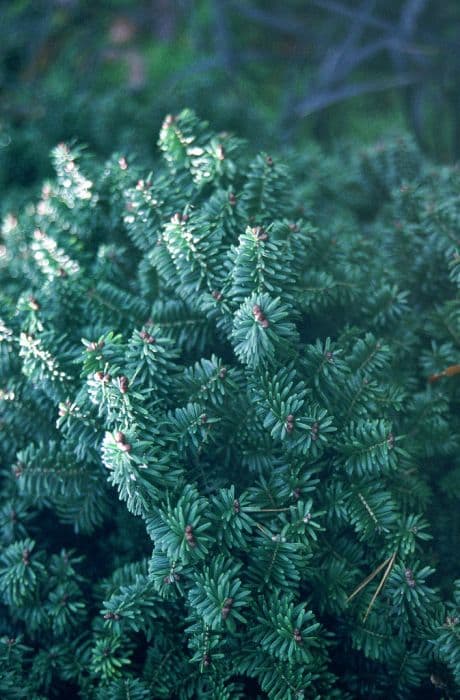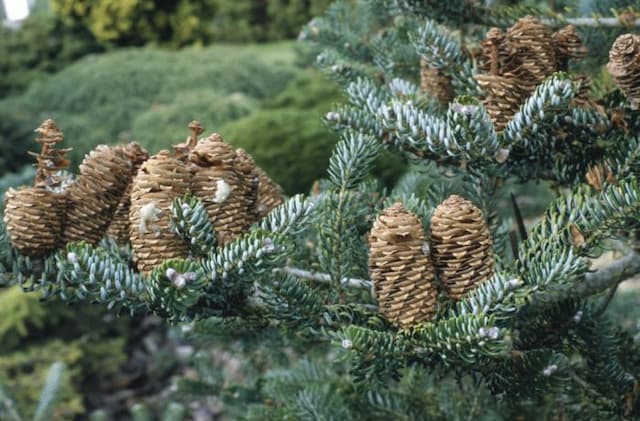Austrian Pine Pinus nigra subsp. nigra

ABOUT
The Austrian pine, also known as black pine, is a robust and hardy coniferous evergreen species with a distinctive appearance. Its bark is deeply fissured and dark gray to black, giving it a rugged texture that becomes more pronounced with age. The needles of this tree are long and stiff, presenting in pairs with a deep green color that persist all year and offer a dense, lush appearance. The Austrian pine is also characterized by its sturdy, conical shape when young, which becomes more irregular as it matures. Its branches spread outwards, providing a broad and full silhouette. The male and female cones of the Austrian pine are quite different in appearance. The male cones are smaller and more inconspicuous, typically yellowish, and clustered. In contrast, the female cones are larger, woody, and hard, ranging from a green to brownish hue as they mature. The seeds within are winged, aiding their dispersal by wind. The overall visual effect of the Austrian pine is one of a solid, enduring tree that offers year-round color and texture to landscapes where it grows.
About this plant
 Names
NamesFamily
Pinaceae.
Synonyms
European Black Pine, Austrian Pine, Black Pine.
Common names
Pinus dalmatica, Pinus laricio, Pinus laricio var. corsicana, Pinus laricio var. maritima, Pinus nigra var. corsicana, Pinus nigra var. maritima, Pinus nigra var. nigra, Pinus nigricans, Pinus pyramidalis.
 Toxicity
ToxicityTo humans
The European black pine is generally not considered toxic to humans. Ingesting parts of this plant typically does not pose a health risk, and there are no widespread reports of poisoning or adverse effects from consuming the needles, bark, or resin. However, it’s always wise to exercise caution and avoid eating parts of ornamental or wild plants unless they are known to be edible.
To pets
The European black pine is not commonly known as a toxic plant to pets. Ingestion of the needles may cause mild gastrointestinal discomfort, such as vomiting or diarrhea, but significant toxicity is not expected. As with any non-food plant, pets should be discouraged from eating significant quantities of the pine needles to prevent potential gastrointestinal upset.
 Characteristics
CharacteristicsLife cycle
Perennials
Foliage type
Evergreen
Color of leaves
Green
Height
50-60 feet (15-18 meters)
Spread
20-30 feet (6-9 meters)
Plant type
Tree
Hardiness zones
4-7
Native area
Mediterranean
Benefits
 General Benefits
General Benefits- Erosion Control: Pinus nigra, commonly known as Austrian pine, has a robust root system that helps stabilize soil and prevent erosion.
- Shade Provider: Its dense foliage offers ample shade in landscapes and urban areas, creating cooler environments during hot weather.
- Windbreak: The tree's thick growth habit makes it an effective windbreak, protecting areas from strong winds and storms.
- Habitat for Wildlife: Austrian pine provides shelter and nesting sites for various bird species and other wildlife.
- Ornamental Use: With its dark green needles and symmetrical shape, it is often used for ornamental landscaping and garden design.
- Timber Production: The wood of Austrian pine is valued for construction and furniture due to its durability and workability.
- Privacy Screen: When planted in rows, Austrian pine can act as a natural privacy screen, blocking unwanted views and noise.
- Recreation: In parks and large gardens, Austrian pine provides a picturesque setting for recreation and relaxation.
 Medical Properties
Medical Properties- Antiseptic: The resin of the Black pine has been used for its antiseptic properties.
- Expectorant: Black pine preparations may act as expectorants, helping in the relief of coughs and congestion.
- Anti-inflammatory: Compounds found in Black pine may possess anti-inflammatory effects, potentially useful in reducing inflammation.
- Aromatherapy: Essential oils derived from Black pine are used in aromatherapy for their soothing properties.
 Air-purifying Qualities
Air-purifying QualitiesThis plant is not specifically known for air purifying qualities.
 Other Uses
Other Uses- Wood Tar Production: The European black pine's wood can be distilled to produce wood tar, which is historically used as a sealant for maritime purposes, as well as in soaps and shampoos for its antiseptic properties.
- Soil Stabilization: With its deep root system, the European black pine can be planted to help prevent soil erosion on slopes and in areas susceptible to landslides.
- Sound Barriers: Due to its dense foliage and tall, evergreen nature, European black pine trees are often planted along highways as natural sound barriers to reduce noise pollution.
- Windbreaks: The trees are effective in acting as windbreaks to protect crops, soil, and residential areas from harsh winds.
- Christmas Trees: Although not as popular as some other species, the European black pine can be grown for use as Christmas trees in certain regions.
- Bonsai Art: Some enthusiasts use European black pine for creating bonsai trees, owing to its aesthetically pleasing form and the ease with which it can be trained and pruned.
- Pine Needles for Mulch: The fallen needles of European black pine can be gathered and used as a natural mulch for gardening, which helps to keep moisture in the soil and deters weeds.
- Wildlife Habitat: The dense branches and foliage provide habitat and shelter for various species of wildlife, including birds and small mammals.
- Charcoal Production: The wood of European black pine is suitable for making charcoal, which is used for grilling food, and also as a drawing material for artists.
- Woodworking and Carpentry: The timber is valuable for general construction, making furniture, and for wood carving thanks to its workability and finish.
Interesting Facts
 Feng Shui
Feng ShuiThe Austrian pine is not used in Feng Shui practice.
 Zodiac Sign Compitability
Zodiac Sign CompitabilityThe Austrian pine is not used in astrology practice.
 Plant Symbolism
Plant Symbolism- Endurance and Longevity: As a species of pine tree, the European Black Pine (Pinus nigra subsp. nigra) often symbolizes endurance and the ability to withstand the test of time, mirroring the long life span and resilience of pine trees.
- Strength: Its sturdy nature and robustness in harsh climates position the European Black Pine as a symbol of strength and steadfastness.
- Resilience: The European Black Pine's ability to thrive in difficult environments makes it a symbol of resilience and adaptability in the face of adversity.
- Wisdom: In some cultures, pine trees represent wisdom and longevity, traits that have been revered throughout the ages, suggesting an association with ancient knowledge and insight.
 Water
WaterThe Austrian Pine, commonly referred to as Pinus nigra subsp. nigra, does well with deep and infrequent watering. It's best to water this conifer by soaking the root area, ensuring that water reaches deep into the soil, which encourages deep root growth. Young trees benefit from about 5 gallons of water once a week, especially during dry spells. As the tree matures, it requires less frequent watering; during the growing season, providing 10 to 15 gallons every two to three weeks is often sufficient. In winter, watering can often be reduced further unless the season is particularly dry.
 Light
LightThe Austrian Pine thrives best in full sunlight, which means it needs at least six hours of direct, unfiltered sunlight each day. The ideal spot for this plant is a location where it is exposed to full sun throughout the day, as it is highly adapted to grow in open, sunny environments. Avoid areas that are shaded for long periods, as insufficient light can affect the tree's health and growth.
 Temperature
TemperatureAustrian Pines are extremely tolerant of a range of temperature conditions and can survive in temperatures as low as minus 40 degrees Fahrenheit to highs well above 100 degrees Fahrenheit. They grow optimally in temperatures typically found in USDA hardiness zones 4 through 7. Ensure they are not in locations prone to extreme temperature fluctuations that could stress the tree.
 Pruning
PruningPruning the Austrian Pine should be done to remove dead or diseased branches, improve air circulation, and maintain the desired shape. Pruning is best done in late winter or early spring before new growth starts. It isn't needed frequently; a visual inspection once a year to identify any problematic branches is usually sufficient. When pruning, it is important to make clean cuts and not to over prune as it can damage the tree.
 Cleaning
CleaningAs needed
 Soil
SoilThe Austrian pine flourishes best in well-drained, sandy to loamy soil with a slightly acidic to neutral pH ranging from 5.5 to 7. The best soil mix includes organic matter such as compost or pine bark fines to ensure proper drainage and fertility.
 Repotting
RepottingAustrian pines are slow-growing trees that typically do not require frequent repotting. They should be repotted every 4 to 5 years or as needed when the root system outgrows the current container.
 Humidity & Misting
Humidity & MistingAustrian pines are adaptable to a wide range of humidity conditions and can generally tolerate the ambient outdoor humidity in most climates where they thrive. They do not require specific humidity levels for growth.
 Suitable locations
Suitable locationsIndoor
Provide bright light, cool temps, and circulate air for indoor Austrian pines.
Outdoor
Plant in full sun, provide ample space, and water deeply for outdoor growth.
Hardiness zone
4-7 USDA
 Life cycle
Life cyclePinus nigra subsp. nigra, commonly known as the European black pine, begins its lifecycle with seed germination, which typically occurs in the spring following stratification to break dormancy. The seedlings develop a taproot and begin to establish a foliage of needles, entering the sapling stage, which can last for several years as the tree slowly matures. During the immature stage, the tree grows in height and girth, developing a sturdy trunk and a symmetrical crown of branches. After reaching maturity, which can take 20-30 years, the tree begins to produce cones—female cones are larger and carry seeds, while the smaller male cones produce pollen. Pollination usually occurs in the spring when the male cones release pollen that is carried by the wind to the female cones, leading to fertilization and seed development. The European black pine can live for several hundred years, continually producing cones annually or biannually, with older trees typically having a thicker, more furrowed bark and a broader crown.
 Propogation
PropogationPropogation time
Spring-Early Summer
The European black pine, Pinus nigra subsp. nigra, is commonly propagated by seed. This is the most popular method for propagating this species. To optimize germination, seeds require a period of cold stratification, which can be achieved by keeping them in a refrigerator at a temperature of around 33-41°F (0.6-5°C) for several weeks. After stratification, the seeds are sown in the spring in well-draining soil and covered lightly with additional soil. They need to be kept moist but not waterlogged; allowing the surface to dry out slightly between waterings can encourage strong root growth. Seedlings usually emerge within a few weeks to months, depending on conditions, and can then be grown on before transplanting to their final location once they have established a robust root system and have grown large enough to handle environmental stresses.









